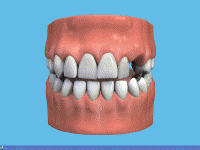
CANINE IN THE PALATE
Q Where is the upper canine?
A This tooth forms high up in the mouth to the side of the nose.
Q What is a canine in the palate?
A The upper canine can fail to grow into its proper place in the mouth. It can often end up in the palate behind the front teeth.
Q Why has this occurred?
A The canine forms high up under the eye (eye-tooth). As it grows down it can lose its way!
Q Will the tooth need to be removed?
A The canine will only need to be removed if it is way off course or damaging the other teeth.
Q How will the tooth be treated?
A Firstly the tooth needs to be exposed (uncovered). This usually involves a trip to the hospital. Once exposed the tooth can then be brought into line with a fixed traintrack brace. This is complicated and can take up to two years.
Q Will I still need a retainer?
A When the fixed brace is removed a retainer will be constructed which will need to be worn at night.
Q How long will the retainer need to be in place?
A The retainer will normally be worn at night for a year. Without the retainer the canine can move back a little bit.
Q Will there be any permanent damage?
A No damage will occur due to moving the tooth. However, poor cleaning and too many fizzy drinks can cause permanent decay marks around the fixings of the traintrack brace. The importance of thorough brushing and the use of a fluoride mouthwash cannot be emphasised enough.
Q Is the treatment permanent, or will I need additional future treatment?
A Once the canine has settled into its proper place the result will be stable.

